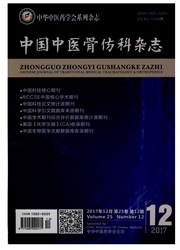

 中文摘要:
中文摘要:
目的:研究一氧化氮(NO)对兔纤维环细胞生物学行为的影响及其相关机制。方法:构建兔纤维环细胞凝胶培养模型并将其为7组,分别向培养基内加入不同浓度的NO供体硝普钠(SNP)及iNOS抑制剂烟酰胺和1400W进行干预:第1组为正常对照组,不加入药物;第2组加入10μmol/LSNP;第3组加入100μmol/LSNP;第4组加入200μmol/LSNP;第5组加入100μmol/LSNP和1μmol/L1400W;第6组加入100μmol/LSNP和0.05mg/mL烟酰胺;第7组加入100μmol/LSNP和0.5mg/mL烟酰胺。干预3d后分别采用MTT法、AnnexinV-PI染色和RT-PCR检测各组纤维环细胞增殖活力、细胞凋亡状况及细胞聚集蛋白多糖(aggrecan)、Ⅰ和Ⅱ型胶原基因表达。结果:①MTT检测显示:第3、4组吸光度值(A)较正常对照组明显下降(均P〈0.05),而第5、6、7组均高于第3组(均P〈0.05)。②流式细胞仪分析显示:第2、3、4组凋亡细胞比例远高于正常对照组,其中第4组高达32.98%;第5、6、7组凋亡细胞比例较第3组均有所下降,但仍高于正常对照组。③RT-PCR显示:第2、3、4组aggrecan、Ⅰ和Ⅱ型胶原基因表达较正常对照组均明显降低(均P〈0.05),而第5、6、7组较第3组均明显增加(均P〈0.05)。结论::NO对兔纤维环细胞生物学行为有较强的干扰作用,可能在纤维环损伤机制中扮演着重要角色。iNOS抑制剂可以有效抑制N0对兔纤维环细胞生物学行为的干扰,具备用于椎间盘退变防治的良好潜力。
 英文摘要:
英文摘要:
Objective:To investigate the regulatory effects and mechanism of nitric oxide (NO) on the biological behavior of rabbit annulus fibrosus (AF) cells. Methods:Rabbit AF cells gel culture model was adopted in this study. Cultured AF cells were divided into 7 groups. Various concentrations of Sodium Nitroprusside (SNP) and iNOS inhibitors (Niacinamide and 1400W) were added to the medium as following: group 1 without any drug as the normal control group, 10μmol/L SNP in group 2, 100μmol/L SNP in group 3, 200μmol/L SNP in group 4, 100μmot/L SNP and 1μmol/L 1400W in group 5, 100μmol/L SNP and 0.05mg/mL Niacinamide in group 6, and 100μmol/L SNP and 0.5mg/mL Niacinamide in group 7. After 3 days, AF cell proliferation, apoptosis and the gene expressions of aggrecan, type Ⅰ and Ⅱ collagen in each group were determined respectively by MTT assay, Annexin V --PI staining and RT--PCR detection. Results: ①The absorbance of MTT assay in group 3 and 4 were decreased significantly compared with normal control group (P〈0.05, respectively), while the absorbance of group 5, 6 and 7 were markedly higher than that of group 3 (P〈0.05, respectively). ② Flow cytometry analysis showed the apoptotic ratio of group 2, 3 and 4 were far higher than that of normal control group, in which the apoptotic ratio of group 4 was 32.98%. And the apoptotic ratio of group 5, 6 and 7 were decreased significantly compared with group 3, but remained higher than that of normal control group. ③RT-PCR showed the gene expressions of aggrecan, typeI and Ⅱ collagen in group 2, 3 and 4 were significantly lower than that of normal control group (P〈0.05, respectively), while the gene expressions of aggrecan, typeⅠ and Ⅱ collagen in group 5, 6 and 7 were markedly increased as compared with group 3 (P〈0.05, respectively). Conclusion: NO has a strong disturbing effect on the biological behavior of rabbit AF cells, which might play an important role in the AF injury. Inhibitors of iNOS can alleviate
 同期刊论文项目
同期刊论文项目
 同项目期刊论文
同项目期刊论文
 Development and evaluation of controllable axial loading-induced rabbit lumbar disc degeneration mod
Development and evaluation of controllable axial loading-induced rabbit lumbar disc degeneration mod Protective effects of Tanshinone ⅡA against interleukin-1 beta induced obstruction of energy metabol
Protective effects of Tanshinone ⅡA against interleukin-1 beta induced obstruction of energy metabol Adenovirus-mediated tissue inhibitor of metalloproteinase-3 gene transfection inhibits rabbit interv
Adenovirus-mediated tissue inhibitor of metalloproteinase-3 gene transfection inhibits rabbit interv 期刊信息
期刊信息
